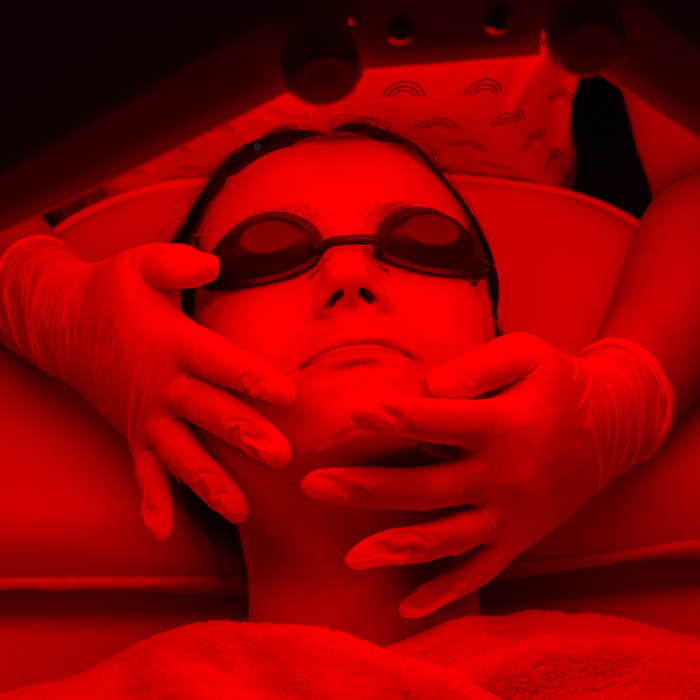100+ Happy Clients
Red Light Therapy
Red light is low-level wavelengths within the red spectrum, typically between 600 to 650 nanometers. Its ability to penetrate the skin and reach deeper tissues benefits health.
When red light hits the cells, it stimulates the mitochondria, the cell’s powerhouse, to produce more energy (ATP). This extra energy helps the body repair itself more efficiently, reduces inflammation, and boosts circulation.

Experience The Healing Power of Red Light Therapy
How Red Light Therapy (RLT) Works
Red Light Therapy (RLT) uses low-level red wavelengths that penetrate the skin, producing a positive biochemical effect on mitochondria. The mitochondria are known as the “powerhouses” of the cell because they produce the energy (ATP) that cells need to function. Healthy mitochondria are essential for all bodily processes, including muscle contraction, brain activity, and organ function. This enhances cellular efficiency, promotes rejuvenation and self-repair, and improves overall health and appearance.
Light doesn’t just brighten our world; it regulates our body clock, boosts mood, and promotes healing.
In 1896 Danish physician Niels Ryberg Finsen pioneered light therapy to treat tuberculosis, earning the Nobel Prize in 1903. Later, in 1967, Hungarian physician Endre Mester developed low-level laser therapy, showing its effectiveness for wound healing.
In the 1930s, NASA discovered that RLT could speed up the healing process of astronauts, driving more research. With advancements in LED technology, RLT became more affordable and widespread, and today, it’s used globally in clinics, wellness centers, and homes for its therapeutic benefits.
Key Benefits of Red Light Therapy
Empowers Mitochondrial Function
RLT stimulates mitochondria to produce more ATP (cellular energy), enhancing overall energy levels, improving cell repair, and supporting optimal bodily functions for faster recovery and better health.
Boosts Overall Mood
Increases serotonin levels, which can help elevate mood and reduce symptoms of depression and anxiety.
Provides Relief From Discomfort
Helps reduce inflammation and pain in conditions such as arthritis and muscle soreness by stimulating cellular repair mechanisms.
Enhances Blood Circulation
Improves blood flow by stimulating nitric oxide production, which helps relax blood vessels and improves overall circulation.
Improves Back Pain and Joint Issues
Clinical trials have shown that red light therapy can significantly reduce chronic back and joint pain by decreasing inflammation and promoting tissue regeneration.
Promotes Better Sleep
Regulates circadian rhythms by increasing melatonin production, which helps improve sleep quality and duration.
Accelerates Wound Healing and Tissue Repair
Stimulates collagen production and increases cellular energy, which speeds up the healing of wounds and injuries.
Diminishes Wrinkles, Fine Lines, and Cellulite
Promotes collagen and elastin production, helping reduce wrinkles, fine lines, and even the appearance of cellulite.
Stimulates Hair Growth
Stimulates hair follicles and improves blood flow to the scalp, promoting hair regrowth in individuals with androgenic alopecia (hair loss).
How To Get Started
At 369 Wellness Center, our dedicated team is committed to helping you achieve your health goals. We work closely with you every step of the way, providing personalized care and support. Call us today to book an appointment and learn how RLT can support your journey to better health.
Call Us
+1 855 369 9369
The 369 Wellness Center Experience
Each treatment lasts 10-20 minutes in a private room, ensuring comfort and privacy. You can relax in our advanced RLT bed while listening to music, taking a nap, or simply enjoying the tranquility of the light. It’s like a rejuvenating mini-vacation for your mind and body.
RLT benefits everyone, providing a UV-free, safe experience suitable for all skin types without side effects.
Medical clinics in the U.S. often overlook Red Light Therapy (RLT) because it’s not part of standard medical school curriculums. Additionally, most insurance companies don’t cover RLT, limiting its availability in traditional healthcare settings. The good news is that it’s widely used today by athletes, celebrities, and regular people worldwide seeking improved health.

